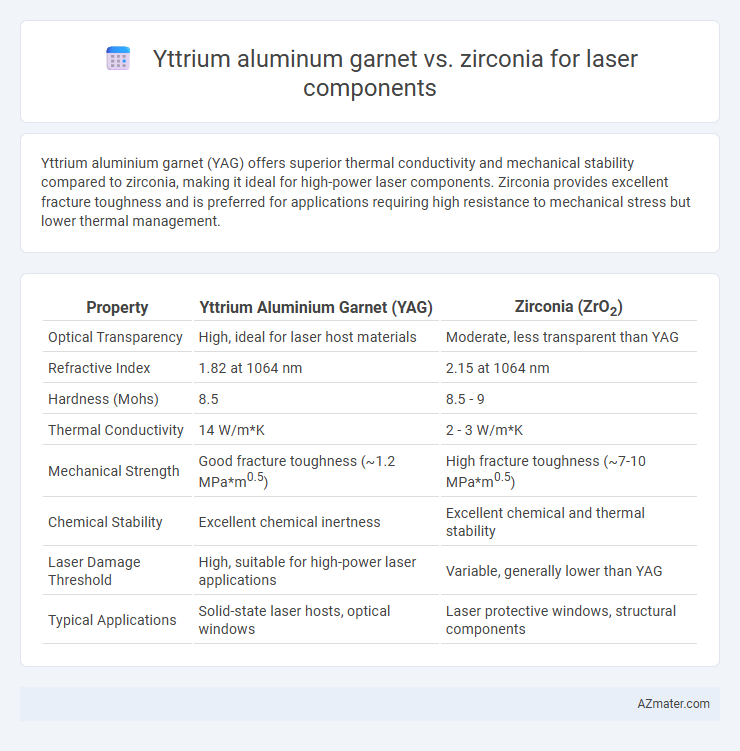Yttrium aluminium garnet (YAG) offers superior thermal conductivity and mechanical stability compared to zirconia, making it ideal for high-power laser components. Zirconia provides excellent fracture toughness and is preferred for applications requiring high resistance to mechanical stress but lower thermal management.
Table of Comparison
| Property | Yttrium Aluminium Garnet (YAG) | Zirconia (ZrO2) |
|---|---|---|
| Optical Transparency | High, ideal for laser host materials | Moderate, less transparent than YAG |
| Refractive Index | 1.82 at 1064 nm | 2.15 at 1064 nm |
| Hardness (Mohs) | 8.5 | 8.5 - 9 |
| Thermal Conductivity | 14 W/m*K | 2 - 3 W/m*K |
| Mechanical Strength | Good fracture toughness (~1.2 MPa*m0.5) | High fracture toughness (~7-10 MPa*m0.5) |
| Chemical Stability | Excellent chemical inertness | Excellent chemical and thermal stability |
| Laser Damage Threshold | High, suitable for high-power laser applications | Variable, generally lower than YAG |
| Typical Applications | Solid-state laser hosts, optical windows | Laser protective windows, structural components |
Introduction to Laser Component Materials
Yttrium aluminium garnet (YAG) and zirconia are critical materials in laser components due to their exceptional optical and thermal properties. YAG is widely preferred for solid-state lasers because of its high thermal conductivity, mechanical strength, and ability to host active ions like neodymium, enabling efficient laser emission. Zirconia excels in applications requiring high fracture toughness and chemical stability, making it ideal for protective coatings and substrates in laser systems.
Yttrium Aluminium Garnet (YAG): Properties and Applications
Yttrium Aluminium Garnet (YAG) offers exceptional thermal conductivity, high melting point of approximately 1970degC, and excellent optical transparency in the visible and infrared spectrum, making it an ideal material for laser components compared to Zirconia. Its low absorption coefficient, mechanical strength, and resistance to thermal shock enable efficient laser performance and durability in high-power solid-state lasers, including Nd:YAG lasers widely used in medical, industrial, and scientific applications. YAG's capacity for precise doping with rare-earth ions like neodymium or erbium enhances its versatility for generating specific laser wavelengths and improving energy conversion efficiency.
Zirconia: Properties and Applications in Lasers
Zirconia, known for its high fracture toughness, thermal stability, and optical transparency across a broad wavelength range, offers significant advantages in laser components compared to yttrium aluminium garnet (YAG). Its superior resistance to thermal shock and mechanical wear makes zirconia ideal for high-power laser windows, lenses, and protective covers in harsh operating environments. The material's birefringence and exceptional hardness further enhance laser beam quality and durability in precision optical systems.
Comparative Optical Properties: YAG vs Zirconia
Yttrium aluminium garnet (YAG) offers superior thermal conductivity and higher laser damage thresholds compared to zirconia, making it ideal for high-power laser components. Zirconia exhibits a wider bandgap and higher refractive index, which enhances its optical transparency in specific infrared wavelengths but at the cost of lower mechanical strength and thermal stability. The choice between YAG and zirconia depends on balancing factors such as laser wavelength compatibility, thermal management, and durability requirements for efficient laser operation.
Thermal Conductivity Differences
Yttrium aluminium garnet (YAG) exhibits a thermal conductivity of approximately 10-14 W/m*K, which allows efficient heat dissipation in laser applications. Zirconia, with a significantly lower thermal conductivity near 2 W/m*K, tends to retain heat longer, posing challenges for thermal management in high-power laser components. The superior thermal conductivity of YAG ensures better temperature stability and reduced thermal lensing compared to zirconia in laser systems.
Mechanical Strength and Durability
Yttrium aluminium garnet (YAG) exhibits superior mechanical strength and durability compared to zirconia, making it highly suitable for laser components subject to high thermal and mechanical stress. YAG's hardness and fracture toughness enable it to withstand intense laser irradiation without significant degradation or cracking. Zirconia offers high toughness but generally lower thermal stability, limiting its long-term durability in high-power laser applications.
Fabrication and Processing Considerations
Yttrium aluminium garnet (YAG) offers superior thermal stability and higher laser damage thresholds, making it ideal for high-power laser components, but its fabrication involves complex crystal growth using the Czochralski method, requiring precise control to avoid defects. Zirconia (ZrO2) components, fabricated primarily through sintering and hot isostatic pressing, provide excellent mechanical strength and fracture toughness but have lower optical clarity and laser damage resistance compared to YAG. Processing YAG demands strict atmospheric controls and slow cooling to prevent cracks, whereas zirconia's polycrystalline nature allows for more cost-effective mass production but limits its use in high-precision laser optics.
Cost Analysis: YAG versus Zirconia Components
Yttrium aluminium garnet (YAG) laser components generally exhibit higher material and manufacturing costs compared to zirconia counterparts due to complex crystal growth and processing requirements. Zirconia, being a polycrystalline ceramic, offers cost advantages through scalable sintering processes and lower raw material expenses while maintaining adequate laser performance in specific applications. Cost analysis favors zirconia for budget-sensitive projects, whereas YAG remains the preferred choice in high-precision, high-durability laser systems despite its premium price.
Performance in High-Power Laser Systems
Yttrium aluminium garnet (YAG) exhibits superior thermal conductivity and high damage threshold, making it ideal for use in high-power laser systems where heat dissipation and durability are critical. Zirconia offers excellent fracture toughness and chemical stability but has lower thermal conductivity compared to YAG, limiting its performance under intense laser irradiation. For applications demanding efficient heat management and long service life in high-power laser components, YAG is generally preferred due to its balanced optical and mechanical properties.
Selection Criteria for Laser Component Manufacturers
Yttrium aluminium garnet (YAG) offers superior thermal conductivity and mechanical strength, making it ideal for high-power laser components requiring durability and efficient heat dissipation. Zirconia provides excellent fracture toughness and chemical stability, preferred in applications needing resistance to harsh environments and frequent mechanical stress. Laser component manufacturers select YAG or Zirconia based on factors such as thermal management requirements, mechanical load conditions, and environmental exposure to optimize laser performance and component longevity.

Infographic: Yttrium aluminium garnet vs Zirconia for Laser component
 azmater.com
azmater.com